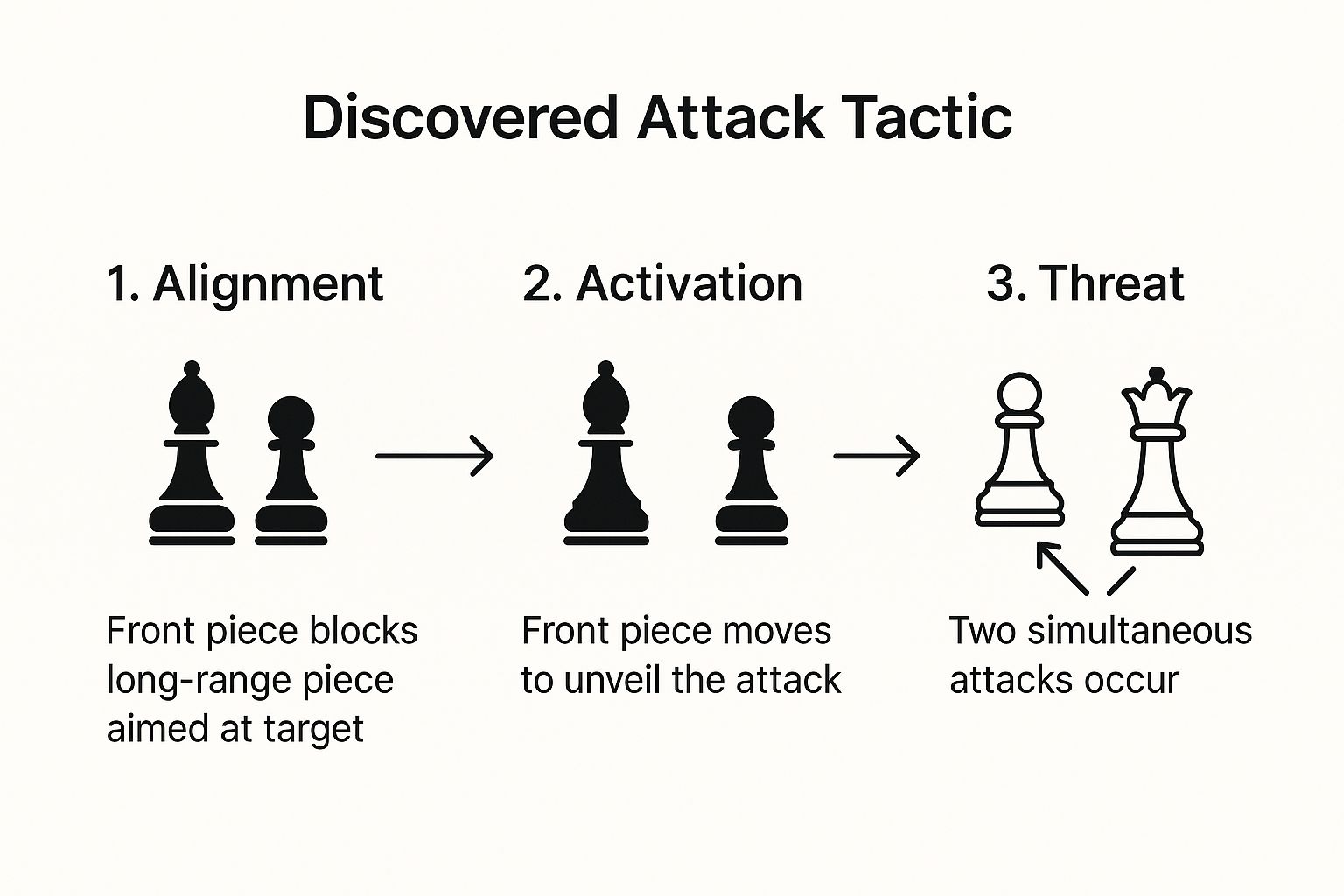Unlocking the Power of Chess Tactics
Chess tactics are essential tools for beginners seeking to improve their game. This listicle presents eight crucial chess tactics for beginners, providing clear explanations and practical examples to enhance your understanding and performance. Mastering these tactics will equip you to outmaneuver opponents and gain a decisive advantage on the board.
This curated collection provides valuable insights into fundamental tactical concepts. Each tactic is presented with practical applications, moving beyond basic theory to demonstrate real-world usage on the chessboard. Whether you aim to secure checkmate or gain material advantage, these tactics offer a pathway to improved strategic thinking. Learning these tactics provides a foundation for more advanced play, enhancing your ability to anticipate your opponent's moves and formulate winning strategies.
This listicle covers the following essential chess tactics for beginners:
- Pin
- Fork
- Skewer
- Discovered Attack
- Double Attack
- Removal of the Defender
- Back Rank Mate
- Decoy
These tactics, explained with clear examples, will empower you to transform your chess game. From recognizing opportunities for a pin to executing a devastating back rank mate, these concepts are fundamental to chess success. This listicle emphasizes the practical application of these tactics, offering specific guidance and real-world scenarios to illustrate their effectiveness.
1. Pin
A pin is a powerful tactic in chess that exploits the limitations of piece movement to create tactical opportunities. It occurs when a piece is attacked and cannot move without exposing a more valuable piece behind it to capture. This effectively immobilizes the pinned piece, rendering it a liability and disrupting the opponent's defensive coordination. Understanding and utilizing pins is fundamental to improving your chess tactics for beginners.

Understanding the Mechanics of a Pin
The pinned piece acts as a shield, protecting the more valuable piece. The attacking piece exerts pressure along a rank, file, or diagonal. The pinned piece is typically of lesser value than the piece behind it. Common scenarios involve a bishop pinning a knight to the king or a rook pinning a piece to the queen.
Practical Examples of Pins
-
Bishop Pin: A bishop attacks a knight positioned diagonally between the bishop and the opponent's king. The knight is pinned because moving it would expose the king to check.
-
Rook Pin: A rook attacks a bishop positioned on the same file between the rook and the opponent's queen. Moving the bishop would allow the rook to capture the queen.
-
Queen Pin: A queen can pin any piece to a more valuable piece along a rank, file, or diagonal. This versatility makes the queen exceptionally potent in creating pins.
Utilizing Pins Effectively
-
Target Identification: Look for alignments of opponent pieces along ranks, files, or diagonals. These alignments often present opportunities for creating pins.
-
Attack with Lesser Pieces: Utilize pawns or less valuable pieces to attack the pinned piece. This maximizes material gain if the opponent is forced to sacrifice the pinned piece to defend the more valuable one.
-
Disrupt Defense: Pins can prevent opponent pieces from defending key squares. This creates weaknesses that can be exploited by other tactical maneuvers.
-
Combination with Other Tactics: Pins often become more powerful when combined with other tactical ideas, such as forks or discovered attacks.
Pins are essential chess tactics for beginners, providing a pathway to seizing control of the board and launching devastating attacks. Mastering this tactic will undoubtedly enhance your overall chess playing ability and improve your understanding of piece interplay and tactical vision. By understanding the mechanics, recognizing opportunities, and implementing the provided tips, players can significantly improve their ability to recognize and capitalize on these critical tactical motifs.
2. Fork
A fork is a potent tactic in chess where one piece simultaneously attacks two or more opponent pieces. This presents the opponent with a dilemma, as they cannot save all threatened pieces, often leading to material loss. Forks can quickly turn the tide of a game, making them essential chess tactics for beginners to grasp. Understanding and utilizing forks is crucial for improving tactical vision and capitalizing on opponent vulnerabilities.

Understanding the Mechanics of a Fork
The forking piece exerts pressure on multiple enemy pieces along different lines of attack. The opponent is forced to choose which piece to save, invariably losing the other. The most common forking pieces are knights, due to their unique L-shaped movement, and queens, given their versatility across ranks, files, and diagonals.
Practical Examples of Forks
-
Knight Fork: A knight attacks the opponent's king and queen simultaneously. The opponent must move the king, allowing the knight to capture the queen.
-
Pawn Fork: A pawn attacks two pieces of equal value, such as two rooks. The opponent can only save one.
-
Queen Fork: A queen, positioned strategically, can target multiple pieces across ranks, files, or diagonals. This can disrupt the opponent's defensive structure and lead to significant material gains.
-
The "Family Fork": This spectacular fork involves a knight attacking the king, queen, and rook simultaneously, showcasing the devastating potential of this tactic.
Utilizing Forks Effectively
-
Target Identification: Scan the board for squares where your pieces can potentially attack multiple opponent pieces. Focus on central squares, as they provide greater forking opportunities.
-
Knight Positioning: Knights excel at forking due to their ability to jump over other pieces. Position your knights on outposts where they can control key squares and create forking threats.
-
Sacrificial Forks: Sometimes, sacrificing a piece to create a powerful fork is advantageous. Calculate the material exchange and evaluate the resulting position.
-
Opponent Coordination: Observe your opponent's piece coordination. Look for weaknesses and vulnerabilities that can be exploited with forks.
Forks are a fundamental tactic that can dramatically impact the outcome of a game. By understanding the mechanics, recognizing opportunities, and employing the provided tips, beginners can significantly enhance their tactical awareness and capitalize on these critical chess motifs. Mastering this tactic will undoubtedly elevate your chess playing ability and improve your understanding of piece interplay and tactical vision.
3. Skewer
A skewer is a potent tactic in chess, essentially the inverse of a pin. It involves attacking a valuable piece, forcing its retreat and exposing a less valuable piece behind it to capture. This tactic exploits the limitations of piece movement, creating opportunities for material gain and disrupting the opponent's position. Understanding and utilizing skewers is crucial for improving your chess tactics for beginners.
Understanding the Mechanics of a Skewer
The skewer relies on a direct attack on a high-value piece, typically the king or queen. This forces the targeted piece to move, uncovering a less valuable piece aligned behind it on the same rank, file, or diagonal. The attacking piece then captures the exposed piece, resulting in a material advantage.
Practical Examples of Skewers
-
Rook Skewer: A rook attacks the opponent's king, forcing it to move. This exposes the queen positioned directly behind the king, allowing the rook to capture the queen.
-
Bishop Skewer: A bishop attacks the opponent's queen along a diagonal. The queen moves, revealing a rook aligned behind it. The bishop then captures the rook.
-
Queen Skewer: Due to its long-range capabilities, the queen can execute skewers along ranks, files, and diagonals. This makes it highly effective in skewering combinations involving the king and other pieces.
Utilizing Skewers Effectively
-
Target Identification: Look for alignments of opponent pieces where a valuable piece is positioned in front of a less valuable one. These alignments suggest potential skewer opportunities.
-
Exploit Checks: Checks are powerful tools for forcing skewers. By checking the king, you compel it to move, potentially exposing a valuable piece behind it.
-
Long-Range Pieces: Rooks, bishops, and queens are ideally suited for executing skewers due to their ability to attack from a distance. Position these pieces strategically to create skewer opportunities.
-
Tactical Combinations: Skewers can be particularly devastating when combined with other tactics like forks or discovered attacks. Look for ways to integrate skewers into more complex tactical sequences. This allows you to capitalize on chess tactics for beginners.
Skewers are vital chess tactics for beginners, offering a direct path to gaining material and disrupting the opponent's defenses. Mastering this tactic sharpens tactical vision and enhances your ability to exploit positional weaknesses. By understanding the mechanics, recognizing opportunities, and implementing the provided tips, players can significantly improve their skill in recognizing and utilizing these decisive tactical motifs.
4. Discovered Attack
A discovered attack is a potent tactic in chess that occurs when moving one piece unveils an attack from another piece positioned behind it. This often results in a devastating double attack, forcing the opponent to address two threats simultaneously. Mastering discovered attacks is crucial for improving your chess tactics for beginners and transitioning to intermediate play.
Understanding the Mechanics of a Discovered Attack
The power of a discovered attack lies in its surprise element and the creation of a double attack. The "discovering" piece often moves with tempo, either developing to a better square or delivering a check. The newly revealed attack from the piece behind can capture material or deliver a decisive checkmate.
The following infographic visualizes the process of a discovered attack unfolding.

The infographic illustrates the three key stages of a discovered attack: the initial alignment where a piece blocks a potential attack, the activation move that unveils the attack, and the resulting double threat.
Practical Examples of Discovered Attacks
-
Bishop and Rook: A bishop moves out of the way, revealing a rook attack on the opponent's queen. The opponent is forced to address the rook's threat, allowing the bishop to move to a more active square.
-
Knight and Bishop: A knight moves with check, simultaneously uncovering a bishop attack on a valuable piece. The opponent must address the check, often losing the attacked piece.
-
Pawn and Queen: A pawn advances, revealing a devastating queen attack on the opponent's rook. This type of discovered attack can quickly change the material balance of the game.
Utilizing Discovered Attacks Effectively
-
Piece Alignment: Look for opportunities to align your pieces so that one piece is blocking the attack of a more powerful piece behind it. Long-range pieces like rooks, bishops, and queens are particularly well-suited for discovered attacks.
-
Discovered Checks: Discovered checks are the most forcing type of discovered attack, as the opponent must address the check immediately. This often leads to winning material or achieving checkmate.
-
Setup and Planning: Position your long-range pieces strategically to create potential discovered attacks. This requires anticipating your opponent's moves and planning several steps ahead.
-
Combination with Other Tactics: Discovered attacks can be even more powerful when combined with other tactics such as forks or pins. This creates complex tactical puzzles that can overwhelm your opponent.
Discovered attacks are vital chess tactics for beginners, offering a powerful way to gain material, deliver checkmate, and control the board. By mastering the mechanics, recognizing opportunities, and implementing these tips, players can significantly elevate their chess skills and tactical vision.
5. Double Attack
A double attack is a powerful tactic in chess where a single move creates two simultaneous threats. This overwhelming pressure forces the opponent to address both threats, often leading to material loss or a weakened position. Mastering double attacks is crucial for improving tactical vision and capitalizing on opportunities in chess games, especially for beginners. Understanding and utilizing this tactic is essential for transitioning from a novice to a more intermediate player.

Understanding the Mechanics of a Double Attack
The core principle is to create two threats with one move. These threats can target any combination of pieces and/or the king. The opponent, limited to one move per turn, can usually only address one threat, allowing you to capitalize on the other. This tactic is especially effective against uncoordinated defenses.
Practical Examples of Double Attacks
-
Fork: A knight forks two higher-value pieces, such as rooks or the queen. The opponent can only save one. This type of double attack is particularly potent due to the knight's unique movement pattern.
-
Check and Attack: A piece simultaneously checks the king and attacks another piece. The opponent must address the check, leaving the other piece vulnerable. This often leads to material gain.
-
Discovered Attack: Moving a piece opens an attack line for another piece, creating a double threat. One piece is attacked, and the opponent must also deal with the newly revealed attack.
Utilizing Double Attacks Effectively
-
Piece Coordination: Position your pieces to support each other and create potential double attack opportunities. Look for squares that allow your pieces to control multiple critical squares.
-
Target High-Value Pieces: Prioritize double attacks that threaten the king or high-value pieces like the queen and rooks. These attacks can lead to significant material advantage or even checkmate.
-
Calculate Carefully: Before executing a double attack, ensure you have calculated all possible responses. Overlooking a defensive move could negate the advantage of your double attack.
-
Recognize Opponent's Potential: Be aware of your opponent's pieces and their potential for double attacks. This awareness allows you to anticipate and defend against their tactical plans.
Double attacks are fundamental chess tactics for beginners, enabling decisive strikes and turning the tide of a game. These attacks exploit vulnerabilities, create opportunities for material gain, and disrupt the opponent's defensive structure. By understanding the mechanics, recognizing opportunities, and implementing the tips above, players can improve their ability to find and execute these critical chess tactics.
6. Removal of Defender
Removal of the defender is a crucial tactic in chess, particularly for beginners seeking to improve their tactical vision. It revolves around eliminating or deflecting a piece that protects another piece or a strategically important square. Once the defender is gone, the previously safeguarded target becomes vulnerable to capture or a subsequent attack. This tactic disrupts the opponent's defensive structure and creates opportunities for material gain or positional advantage. Understanding this tactic is essential for improving your chess tactics for beginners.
Understanding Defender Removal
The core principle of this tactic is to exploit the interconnectedness of piece protection in chess. Often, a single piece may be responsible for defending multiple targets. By identifying and eliminating this key defender, you can create multiple weaknesses in the opponent's position. The removal can be achieved through capture, forcing a move by threat, or even a well-calculated sacrifice.
Practical Examples of Defender Removal
-
Capture: A knight defends the opponent's queen. Capturing the knight with a bishop opens up an attack on the queen.
-
Deflection: A rook defends a critical square preventing checkmate. Sacrificing a pawn to force the rook to move allows the checkmate to occur.
-
Forced Move: A bishop defends the opponent’s king. Attacking the bishop with a knight forces it to move, exposing the king to a discovered attack.
Utilizing Defender Removal Effectively
-
Identify Key Defenders: Look for pieces defending multiple targets or particularly valuable pieces. These are prime candidates for removal.
-
Overloaded Pieces: Recognize pieces performing too many defensive duties. They are often weak points in the opponent's defense.
-
Sacrifice: Consider sacrificing material to eliminate a critical defender, especially if it leads to a significant material gain or checkmate.
-
Calculate the Exchange: Before removing a defender, always assess the value exchange. Ensure the gain outweighs the cost.
Removing the defender is a potent weapon in a beginner's tactical arsenal. By mastering this tactic, you can transition from simply reacting to opponent's moves to actively creating weaknesses and launching effective attacks. This tactic sharpens your ability to analyze piece relationships and recognize tactical opportunities, significantly contributing to your overall chess improvement. By understanding the mechanics, recognizing opportunities, and implementing the provided tips, players can significantly improve their ability to recognize and capitalize on these critical tactical motifs within chess tactics for beginners.
7. Back Rank Mate
A back rank mate is a common checkmating pattern in chess that exploits a king's vulnerability when confined to its back rank (the first or eighth rank). This tactic occurs when the opponent's king is trapped by its own pawns on the back rank, and a rook or queen delivers the checkmate along that rank. Understanding this fundamental tactic is crucial for both attacking and defending in chess, especially for beginners. Mastering back rank awareness will significantly improve your tactical vision and defensive capabilities.
[Optional image]
Understanding the Mechanics of a Back Rank Mate
The key element of a back rank mate is the opponent's king being hemmed in by its own pawns on the back rank. This restricted mobility makes the king susceptible to a checkmate along the rank by a rook or queen. The opponent's pieces often obstruct the king's escape squares, further solidifying the trap. Recognizing these positional weaknesses is the first step towards exploiting them or preventing them.
Practical Examples of Back Rank Mates
-
Rook Mate: A classic example involves a rook positioned on the opponent's back rank, with the king trapped by its own pawns. The rook delivers checkmate, and the king has nowhere to escape.
-
Queen Sacrifice: Sometimes a queen sacrifice can clear the path for a rook to deliver a back rank mate. This sacrifice disrupts the opponent's defense and forces a checkmate.
-
Double Rook Coordination: Two rooks working in tandem on the back rank can create unstoppable mating threats. The presence of two rooks intensifies the pressure and limits the opponent's defensive options.
Utilizing Back Rank Mates Effectively
-
Target Identification: Look for kings confined to their back rank by pawns. This is a prime indicator of potential back rank weaknesses.
-
Clear the Rank: Consider piece sacrifices to remove defenders blocking the back rank. This clears the path for your rook or queen to deliver the checkmate.
-
Deflection: Use deflection tactics to lure away defenders of the back rank. This weakens the opponent's protection of the king and creates mating opportunities.
-
Create Luft: Develop your own king safely and create escape squares (luft) to prevent back rank mates against you. This proactive approach safeguards your king from similar tactical vulnerabilities.
Back rank mates are a fundamental tactic in chess for beginners. By recognizing the patterns and applying the provided tips, you can effectively exploit opponent vulnerabilities and secure victories, or defend against these threats in your own games. This understanding of back rank weaknesses enhances both offensive and defensive capabilities, contributing to improved tactical awareness and overall chess proficiency.
8. Decoy
A decoy is a cunning tactic in chess that lures an opponent's piece to a square where it becomes vulnerable or hinders their defensive strategy. This maneuver disrupts the opponent's coordination and creates opportunities for tactical exploitation. Mastering decoys is crucial for improving your chess tactics for beginners and transitioning to more advanced play.
Understanding the Mechanics of a Decoy
A decoy involves sacrificing material or position to entice the opponent's piece to a specific square. This target square is typically weak defensively, exposes the piece to attack, or obstructs other defensive responsibilities. The success of a decoy relies on anticipating the opponent's likely response and calculating the resulting advantages.
Practical Examples of Decoys
-
Queen Sacrifice: Sacrificing the queen to force the king to a square where it can be forked by a knight or bishop. This can lead to checkmate or significant material gain.
-
Rook Sacrifice: Luring a defending rook away from a key file or rank to expose a more valuable piece, such as the king or queen, to attack.
-
Pawn Sacrifice: Sacrificing a pawn to force an opponent's piece to block an escape route for another piece, effectively trapping it.
Utilizing Decoys Effectively
-
Look for Forcing Moves: Checks and captures are often effective ways to initiate a decoy as they compel a response from the opponent.
-
Identify Weak Squares: Analyze the board for squares where opponent pieces would be poorly placed defensively or where they obstruct other pieces.
-
Calculate Responses: Before implementing a decoy, carefully calculate all possible responses to ensure the tactic leads to a favorable outcome.
-
Combine with Other Tactics: Decoys are particularly potent when combined with other tactics like forks, skewers, or discovered attacks.
Decoys are sophisticated chess tactics for beginners that demonstrate the power of strategic sacrifice. By understanding the underlying mechanics and practicing the application of decoys, players can significantly enhance their tactical vision and ability to create complex combinations. Mastering this tactic adds a layer of deception and calculation to your game, allowing you to outmaneuver opponents and secure advantageous positions.
Chess Tactics: Side-by-Side Comparison of 8 Key Techniques
| Tactical Motif | Implementation Complexity 🔄 | Resource Requirements ⚡ | Expected Outcomes 📊 | Ideal Use Cases 💡 | Key Advantages ⭐ |
|---|---|---|---|---|---|
| Pin | Moderate 🔄 | Low ⚡ | Positional restriction and material gain 📊 | Immobilizing key opponent pieces, creating attack opportunities | Restricts mobility, easy to recognize ⭐ |
| Fork | Moderate 🔄 | Medium ⚡ | Immediate material gain 📊 | Attacking multiple pieces simultaneously to gain material | High success rate, immediate advantage ⭐ |
| Skewer | Moderate 🔄 | Medium ⚡ | Material gain by forcing valuable piece to move 📊 | Exploiting aligned valuable pieces to expose vulnerable targets | Targets high-value pieces, often unavoidable ⭐ |
| Discovered Attack | High 🔄 | High ⚡ | Multiple simultaneous threats, often decisive 📊 | Coordinated piece moves revealing hidden attacks | Very powerful, creates double threats ⭐ |
| Double Attack | Moderate 🔄 | Medium ⚡ | Multiple threats causing defensive dilemmas 📊 | Moves that threaten two different targets simultaneously | Maximizes move efficiency, complex threats ⭐ |
| Removal of Defender | Moderate 🔄 | Medium ⚡ | Breaks opponent’s defense, material or positional gain 📊 | Eliminating key defenders to expose targets | Breaks defensive coordination, tactical setups ⭐ |
| Back Rank Mate | Low 🔄 | Low ⚡ | Instant checkmate 📊 | Opponent’s king trapped on back rank by own pawns | Decisive, common mating pattern ⭐ |
| Decoy | High 🔄 | Medium ⚡ | Forces opponent piece to disadvantageous square 📊 | Forcing moves that disrupt opponent’s defense or coordination | Disrupts coordination, creates tactical chances ⭐ |
Mastering Chess Tactics: Your Path to Victory
This curated collection of eight essential chess tactics for beginners provides the foundational knowledge needed to transition from novice to a more strategic player. From the subtle power of the pin to the swift execution of a back-rank mate, each tactic offers a unique avenue to gain an advantage over your opponent. Internalizing these core principles will elevate your game and transform your approach to the chessboard.
Key Takeaways: Converting Knowledge into Action
Throughout this article, we've explored the defining characteristics of each tactic, illustrating their application with practical examples. Let's recap the most crucial takeaways:
- Understanding the Mechanisms: Recognizing the underlying mechanics of each tactic is paramount. A pin restricts piece movement, while a fork attacks two pieces simultaneously. Grasping these differences is key to effective implementation.
- Pattern Recognition: Training your eye to spot tactical opportunities is essential. Regular practice will enhance your ability to identify potential pins, skewers, discovered attacks, and more, even in complex board positions.
- Calculation and Visualization: Chess tactics often involve calculating the consequences of several moves. Develop your ability to visualize future board states and anticipate your opponent's responses.
From Beginner to Tactician: The Journey Ahead
Mastering these chess tactics for beginners is not merely about memorizing definitions. It's about integrating them into your playing style, developing a tactical intuition, and using them proactively to seize opportunities. As you gain experience, you will learn to combine these individual tactics into powerful combinations, creating a synergistic effect that can dismantle even the most robust defenses.
The Value of Tactical Proficiency
The benefits of understanding and applying these tactics extend beyond simply winning games. They contribute to a deeper understanding of chess strategy, enhance your ability to formulate plans, and improve your overall decision-making process on the board. By consistently employing these techniques, you'll transform from a reactive player into a proactive force, dictating the flow of the game and controlling your destiny on the checkered battlefield.
Elevate Your Game with MarbleCultures
Enhance your chess journey with a chess set as captivating as the game itself. Explore the exquisite collection at MarbleCultures and find the perfect board to complement your growing tactical prowess. MarbleCultures offers a stunning range of high-quality chess sets, ideal for practicing these newly acquired skills and elevating your chess experience.

